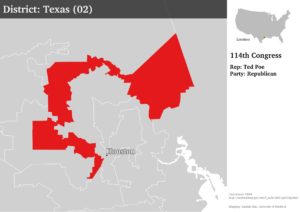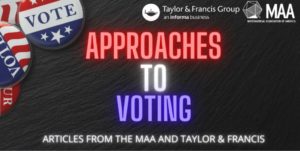
I voted yesterday. That is only noteworthy because it is still October. Early voting is one of the nicer firsts in 2020. One of the amendments on the Virginia ballot would establish a commission to try to reduce gerrymandering. This is on the heels of an excellent MCSP Conversation Series on gerrymandering by Ellen Veomett of Saint Mary’s College.
The commission to draw district lines would be split equally between Democrats and Republicans, but the legislation does not mention how many mathematicians would be involved. You may think that I’m trying to be funny with that comment. However, there is a long established and active area of mathematics devoted to quantifying the reasonableness of the shape of a district. Such objective measures of gerrymandering should be essential tools used by any districting commission.
More generally, there is a long history of mathematical contributions to political concerns such as districting, apportionment, and voting methods. In fact, the Mathematical Association of America just released a collection of articles on mathematical approaches to voting. (See https://think.taylorandfrancis.com/maa-approaches-to-voting/) One quick brag: the first article referenced has one co-author “G. Minton” who is my son, Greg.
Did you know that the first Presidential veto was over how to round numbers? In deciding the number of Representatives a state gets (i.e., apportionment), the general principle is that a state with 8.4% of the country’s population should get 8.4% of the Representatives. But what if the House of Representatives has 435 seats, and 8.4% of 435 is 36.5? Should this state get 36 or 37 Representatives? It turns out that it is very difficult to find a rounding method that can be applied to every state’s quota and has the total number of Representatives add up to 435.
The method to use for the country’s first apportionment was hotly contested between proposals from Thomas Jefferson and Alexander Hamilton. This could have been a showstopper in the musical! Congress approved Hamilton’s method, but George Washington vetoed it. The history of Congressional apportionment is fascinating because of the surprising ways that rounding methods can behave. Check it out in the book The History of Congressional Apportionment by Charles Biles.
And vote!












